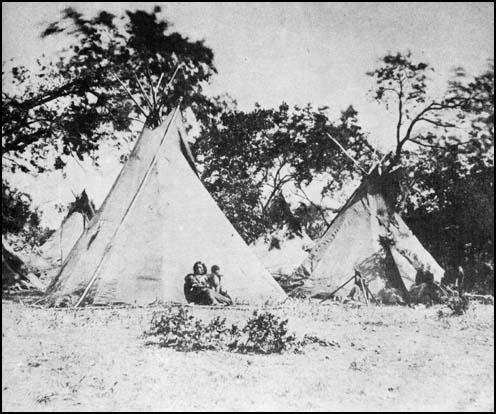Arapaho
The Arapaho were originally farmers who lived in Minnesota. They eventually migrated to the Plains and by the 19th century they were living along both the Platte and Arkansas rivers. The Arapaho became buffalo hunters. This brought them into conflict with other tribes in the area such as the Comanche, Crow, Kiowa, Pawnee, Sioux, Shoshoni, and the Ute.
In 1851 Arapaho leaders signed a peace treaty at Fort Laramie. However, some tribal warriors continued to attack white settlers in the area. In 1867 Little Raven agreed to the Treaty of Medicine Lodge and as a result the Arapaho were placed on a reservation in Oklahoma. Arapaho leaders continued to negotiate and they were finally granted the right to live on the White River Reservation. Their old enemies, the Shoshoni, who also lived on this reservation, complained bitterly about this arrangement. Chief Washakie helped to resolve the problem by persuading one of his sons to marry a Arapaho woman.
By the 20th century, about 2,000 Arapaho were living on a reservation in Wyoming and more than 3,000 were located in Oklahoma.

Primary Sources
(1) Frances M. Roe, letter (January, 1873)
Fancy our having given a dinner party at this sand-bag castle on the plains, miles and miles from a white man or woman! The number of guests was small, but their rank was immense, for we entertained Powder-Face, Chief of the Arapahoe Nation, and Wauk, his young squaw, mother of his little chief.
Two or three days ago Powder-Face came to make a formal call upon the "White Chief," and brought with him two other Indians - aides we would call them, I presume. A soldier offered to hold his horse, but he would not dismount, and sat his horse with grave dignity until Faye went out and in person invited him to come in and have a smoke. He is an Indian of striking personality - is rather tall, with square, broad shoulders, and the poise of his head tells one at once that he is not an ordinary savage.
We must have found favor with him, for as he was going away he announced that he would come again the next day and bring his squaw with him. Then Faye, in his hospitable way, invited them to a midday dinner! I was almost speechless from horror at the very thought of sitting at a table with an Indian, no matter how great a chief he might be. But I could say nothing, of course, and he rode away with the understanding that he was to return the following day. Faye assured me that it would be amusing to watch them, and be a break in the monotony here.
They appeared promptly, and I became interested in Wauk at once, for she was a remarkable squaw. Tall and slender, with rather a thin, girlish face, very unlike the short, fat squaws one usually sees, and she had the appearance of being rather tidy, too. I could not tell if she was dressed specially for the occasion, as I had never seen her before, but everything she had on was beautifully embroidered with beads - mostly white - and small teeth of animals. She wore a sort of short skirt, high leggings, and of course moccasins, and around her shoulders and falling far below her waist was a queer-shaped garment - neither cape nor shawl - dotted closely all over with tiny teeth, which were fastened on at one end and left to dangle.
High up around her neck was a dog collar of fine teeth that was really beautiful, and there were several necklaces of different lengths hanging below it, one of which was of polished elk teeth and very rare. The skins of all her clothing had been tanned until they were as soft as kid. Any number of bracelets were on her arms, many of them made of tin, I think. Her hair was parted and hung in loose ropes down each shoulder in front. Her feet and hands were very small, even for an Indian, and showed that life had been kind to her. I am confident that she must have been a princess by birth, she was so different from all squaws I have seen. She could not speak one word of English, but her lord, whom she seemed to adore, could make himself understood very well by signs and a word now and then.
Powder-Face wore a blanket, but underneath it was a shirt of fine skins, the front of which was almost covered with teeth, beads, and wampum. His hair was roped on each side and hung in front, and the scalp lock on top was made conspicuous by the usual long feather stuck through it.
Chief Powder-Face, who is really not old, is respected by everyone, and has been instrumental in causing the Arapahoe nation to cease hostilities toward white people. Some of the chiefs of lesser rank have much of the dignity of high-born savages, particularly Lone Wolf and his son Big Mouth, both of whom come to see us now and then. Lone Wolf is no longer a warrior, and of course no longer wears a scalp lock and strings of wampum and beads, and would like to have you believe that he has ever been the white man's friend, but I suspect that even now there might be brought forth an old war belt with hanging scalps that could tell of massacre, torture, and murder. Big Mouth is a war chief, and has the same grand physique as Powder-Face and a personality almost as striking. His hair is simply splendid, wonderfully heavy and long and very glossy. His scalp lock is most artistic, and undoubtedly kept in order by a squaw.
